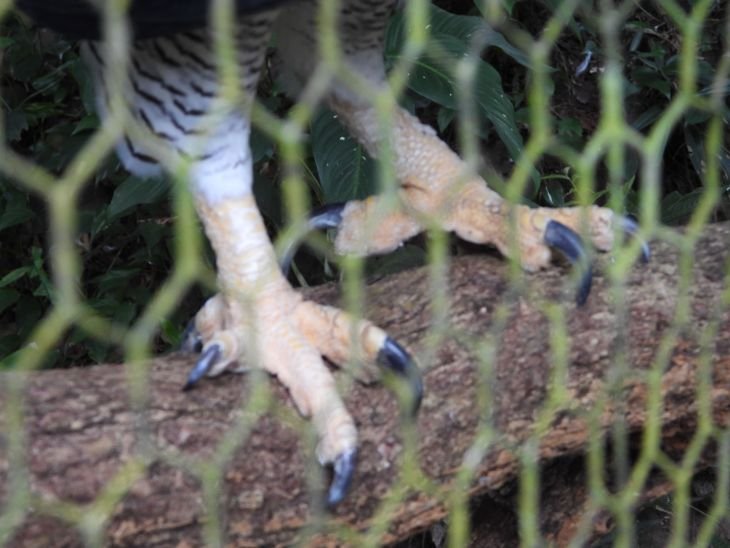Harpy Eagles, the Largest Raptors of Belize
The harpy eagle (Harpia harpyja) is the largest eagle species in the Americas. Harpy eagles are neotropical, meaning that they’re found in the tropical forests of southern Mexico, Central America, and South America. These raptors’ size and strength places them among the top predators of the rainforests throughout their range.
Harpy eagles are primarily dark gray to black along their backs, upper wings, and necks. A harpy eagle’s face is lighter gray, with a crest of darker feathers that can be raised for intimidation or to improve the bird’s hearing, while its chest and belly are light gray to white. From the underside, a harpy eagle’s wing feathers are light gray marked with darker stripes, or bars.
A harpy eagle with wings extended. Credit: Jonathan Wilkins, 27 February 2013.
By weight, the harpy eagle is the second-largest eagle in the world! Female harpy eagles can weigh nearly 20 pounds (9 kg), while males are slightly smaller, between 11 lbs (5 kg) and 17.5 lbs (8 kg). An adult harpy eagle’s wingspan measures up to 79 inches, or over 6.5 feet (2 meters), over twice the length of its body. Most impressively, a harpy eagle’s massive talons measure between 3 and 5 inches (7 to 12.5 cm), a size comparable to the claws of a grizzly bear!
These ferocious talons come into use while hunting. Like other raptors, harpy eagles are carnivores; their prey includes a wide variety of animals, from lizards and snakes to mammals such as agoutis, armadillos, and monkeys, and even to other birds. Harpy eagles have been known to prey on animals as large as young deer!
When hunting in the rainforest, a harpy eagle will perch on a branch high in the canopy, remaining patiently for hours at a time and using its fine-tuned hearing to identify its prey. Once it spots its unlucky target, the eagle dives from the branch to snare its meal with its talons. Harpy eagles prefer to hunt from the trees, but can occasionally be seen on forest edges or in clearings.
The talons of a harpy eagle at the Belize Zoo. Photo by Inspire EdVentures.
Harpy eagles are monogamous, meaning that they mate for life. Pairs of harpy eagles build nests up to 5 feet (1.5 meters) across and lay clutches of two eggs; however, parents will concentrate care on only one egg and chick to raise. Harpy eagle chicks fledge (that is, begin to fly) within six months of hatching, though the young eagle will remain with its parents for up to a year. Adult harpy eagle pairs are very protective of their young; they will even attack humans who come too close to their nests. These eagles reach maturity at around 5 years, and can live up to 35 years in the wild.
Harpy Eagles in Belize
Harpy eagle populations are in decline. Originally listed as Least Concern by the IUCN Red List, the species was updated to Near Threatened in 2011, and updated to Vulnerable to 2021, due to a decreasing population and habitat. Like many other rainforest species, harpy eagles are impacted by habitat loss through deforestation and climate change. Harpy eagles are also threatened by hunting, both for trophies and because of public perception of these eagles as dangerous predators.
Harpy eagles are endemic (native) to Belize, though for many years they were feared to be extinct or nearly extinct in the country. Between 1980 and 2000, there were only five confirmed harpy eagle sightings in Belize, and a breeding pair of harpy eagles was not observed in Belize until 2010. Currently, harpy eagles are believed to be extinct in El Salvador.
In 2003, the Belize Harpy Eagle Restoration Program (BHERP), led by Belize Zoo founder Sharon Matola, was implemented to release captive-bred harpy eagles from Peregrine Fund Panama into Belize’s Chiquibul Forest Reserve, with the goal of re-establishing a healthy Belize harpy eagle population. Additionally, BHERP worked to spread education programs about the importance of harpy eagles, helping to change public opinion of the birds and further protect their population.
Panama, a male harpy eagle at the Belize Zoo. Panama was named for his country of origin and brought to Belize as part of the Belize Harpy Eagle Restoration Program, acting as an animal ambassador to teach Belize Zoo visitors about the importance of his species. Image by Inspire EdVentures.
Harpy eagles, like many other top predators, are of great importance to their native ecosystems. Though it may seem counterintuitive, the presence of predators actually increases biodiversity, in that they keep prey species from overwhelming and damaging their habitats. Because of this, harpy eagles can be considered both a keystone species (a species whose presence is critical for an ecosystem’s function) and an umbrella species (a species whose conservation benefits the ecosystem as a whole). In other words, harpy eagle conservation and reintroduction helps protect the entirety of Belize’s rainforests!
To learn more about harpy eagles and the inhabitants of Belize’s rainforests, visit the Belize Zoo with us at Belize Zoo Live!
Kayla is a biologist and science writer specializing in ecology and conservation. She is a graduate from North Carolina State University and project manager for Inspire EdVentures since 2020.
References and Further Reading
Harpy Eagles at the Belize Zoo
Harpy Eagles at Animal Diversity Web
Harpy Eagles at The Peregrine Fund
Harpy Eagles at the IUCN Red List
Belize Harpy Eagle Restoration Program at the Belize Zoo
Miranda, Everton. (2018). Prey Composition of Harpy Eagles ( Harpia harpyja ) in Raleighvallen, Suriname. Tropical Conservation Science. 11. https://doi.org/10.1177/1940082918800789
James A. Rotenberg, Jacob A. Marlin, Liberato Pop, and William Garcia “First Record of a Harpy Eagle (Harpia harpyja) Nest in Belize,” The Wilson Journal of Ornithology 124(2), 292-297, (1 June 2012). https://doi.org/10.1676/11-156.1



